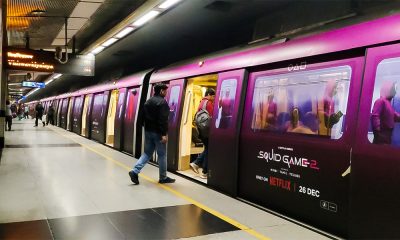Digital Network
‘Advertisers and brands are poised to leverage AI, automation and programmatic technologies’
Franck Vidal, Director, Southeast Asia Sales & Partnership, Vistar Media explains how the convergence of technology and creativity in pDOOH promises not just to elevate brand visibility but also redefine how brands interact with consumers in real-world environments

As India prepares to host the upcoming annual OOH Advertising Convention (OAC), the role of AI, automation, and programmatic technology in out-of-home (OOH) advertising takes centre stage. This transformative trio is not just reshaping the advertising landscape globally but is particularly pivotal in India, where the market dynamics and consumer behaviours present unique opportunities and challenges.
The vast and diverse cultural tapestry in India, allows advertisers to create highly localised and culturally relevant campaigns. The rapid urbanisation and growth of smart cities provide numerous digital touchpoints for innovative and dynamic advertising. Additionally, the high footfall in bustling urban areas and public transport hubs presents an unmatched potential for broad and impactful audience reach.
Embracing true addressability
In the vibrant streets of Bengaluru, where consumer attention is a prized commodity, programmatic digital out-of-home (DOOH) is transforming brand engagement. Unlike traditional static billboards, pDOOH offers dynamic, contextually relevant content that adapts in real-time based on audience demographics, location-specific insights, and even environmental factors like weather and cultural events. This level of true addressability ensures that every advertising rupee spent resonates effectively with the diverse and dynamic consumer base.
Programmatic technology enhances the flexibility and efficiency of DOOH by making OOH truly addressable through point-of-interest strategies and the ability to launch, pause, or adjust campaigns instantly. It allows for impression-level targeting by using mobile devices as real-world cookies, enabling precise examination of exposed audiences and measurement of brand uplift, footfall, and web conversions.
Leveraging data-driven insights
The power of AI and automation in pDOOH lies in its ability to process vast amounts of data to deliver actionable insights. Advertisers in India can now make informed decisions, adjusting their campaigns instantaneously to capitalise on emerging trends or consumer behaviours. For example, a mobile phone manufacturer can target tech-savvy millennials during major smartphone launches, leveraging real-time bidding strategies to ensure their message reaches the right audience at the right time and place across India’s bustling metros.
In the APAC region, continuous efforts are being made to enhance services and deliver higher measurability standards for DOOH. With enhancements to flexibility and planning tools, advertisers can activate campaigns within hours. Robust reporting makes a tangible difference, allowing brands to consolidate campaign outcomes across various publishers and venue types.
Precision Targeting for Maximum Impact
pDOOH not only enhances efficiency but also sharpens targeting to unprecedented levels. Advertisers can deploy AI-driven algorithms to segment Indian audiences based on behavioural patterns, lifestyle choices, and contextual triggers specific to the local market. This precision targeting not only boosts engagement metrics but also drives tangible outcomes such as increased foot traffic to retail stores, measurable brand uplift, and higher online conversions.
There are cross-market benefits that should not be forgotten either. Buyers can utilise specific audience segments to make purchases not only across India but globally, using first- or third-party data. They can implement consistent targeting tactics or leverage the flexibility provided by DOOH across different regions. This capability allows consistent targeting tactics and leverages DOOH’s flexibility across different regions. For instance, a buyer in India can seamlessly purchase inventory in markets like the US, UK, Singapore, and Australia.
Adapting to India’s diverse market dynamics
India’s vast cultural diversity and rapidly evolving urban landscape demand agile and adaptable advertising strategies. pDOOH offers flexibility in campaign deployment, allowing advertisers to seamlessly integrate with broader omnichannel strategies. Whether it’s leveraging local festivals in Kolkata, monsoon season in Mumbai, or the cricket fever gripping Chennai, pDOOH enables brands to align their messages with the pulse of Indian consumers, fostering deeper brand connections and lasting impressions.
As we anticipate discussions at the OOH Advertising Convention in Bengaluru, it’s clear that the future of advertising in India is increasingly digital and data-driven. Advertisers and brands alike are poised to leverage AI, automation, and programmatic technologies not just to reach but to engage and influence the diverse demographics across urban and rural India. Much like media buyers in India buying into other countries with well-developed and impactful AI and pDOOH, the growth of AI and technology in the market in India will see buyers in other countries buying into India, bolstering media owners locally. The convergence of technology and creativity in pDOOH promises not just to elevate brand visibility but to redefine how brands interact with consumers in real-world environments.
The adoption of AI, automation, and programmatic DOOH emerges as a strategic imperative for advertisers looking to navigate the complexities of the Indian market. By harnessing these technologies to deliver personalised, contextually relevant advertising experiences, brands can forge deeper connections and achieve measurable results in the dynamic landscape of Indian advertising.
-

 Campaigns
CampaignsNetflix India goes full green light on OOH with Squid Game season 2
-

 Creative Concepts
Creative ConceptsSkechers launches 3D cricket shoe Bus Shelters in Mumbai
-

 Campaigns
CampaignsBeing Human marks Salman Khan’s birthday with a bold OOH campaign
-

 Sustainability
SustainabilityStatus of sustainable printing in the OOH Industry: Challenges and pathways forward





















